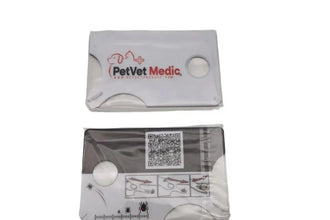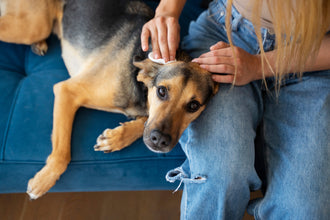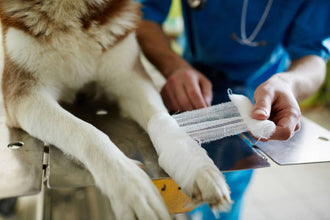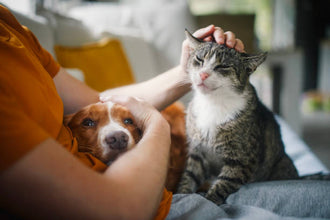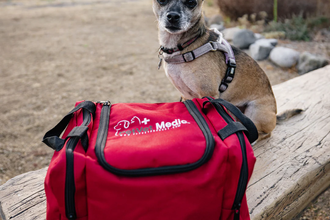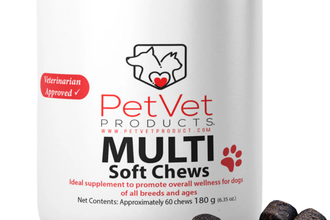
When it comes to the safety and well-being of your pets, being prepared for any emergency is crucial. Whether at home or out and about, accidents can happen. From cuts and scrapes to more serious injuries, having a pet first aid kit on hand can make all the difference. At Pet Vet Products, we provide you with the tools and knowledge you need to handle pet emergencies effectively. Here, we will provide you with a step-by-step pet first aid guide on how to create a complete pet first aid kit that will give you peace of mind, knowing that you’re ready for any situation.
Why Every Pet Owner Needs a First Aid Kit?

Accidents can happen at any time. Whether it's a minor cut or a more serious injury, being prepared for emergencies is essential. A pet first aid kit gives you the peace of mind that you’ll be able to react quickly and correctly. From dog injury treatment to handling common illnesses, the right supplies can help you keep your pet comfortable until professional help arrives.
We offer complete first aid kits and resources, including an in-depth pet first aid guide. Our kits are designed by veterinarians and are perfect for both everyday use and emergencies. Dr. Leah Hill, with over 25 years of experience, leads our team and has carefully curated these kits to ensure you have everything you need.
What Should Be in Your Pet First Aid Kit?
Creating your own pet first aid kit doesn't have to be complicated. With the right pet care supplies, you can be well-prepared for a range of situations. Here's a list of the essential items every pet first aid kit should include:
- First Aid Book or Guide
It's important to have a pet first aid guide in your kit. A comprehensive and easy-to-read book can provide step-by-step instructions on how to treat injuries and illnesses. It should include advice on how to handle common pet emergencies like cuts, burns, or choking, as well as information on more serious conditions.
- Sterile Gauze and Bandages
For treating cuts or abrasions, sterile gauze and bandages are essential. These materials help clean and cover wounds, reducing the risk of infection. Make sure you have various sizes of gauze and bandages to accommodate different types of injuries.
- Adhesive Tape
Adhesive tape will help secure bandages and gauze in place, preventing them from slipping off and exposing the injury. Opt for a type of tape that’s safe for pets and won’t cause skin irritation.
- Antiseptic Wipes or Solution
To prevent infections, antiseptic wipes or solutions are necessary. Clean any cuts or scrapes with these to kill harmful bacteria before bandaging the wound. Ensure that the product is safe for animals and free from harsh chemicals.
- Tweezers and Scissors
Tweezers are useful for removing splinters, ticks, or other foreign objects from your pet's skin. Scissors, especially those with blunt ends, are ideal for cutting tape, gauze, or trimming fur around an injury.
- Thermometer
A thermometer is essential for checking your pet's temperature if they are feeling unwell. Knowing their body temperature can help you determine if they are experiencing a fever or other issues that may require professional attention.
- Hydrocortisone Cream
Hydrocortisone cream can be used to relieve itching caused by allergies or insect bites. It helps reduce inflammation and calms irritated skin. Make sure your pet doesn’t lick the cream off, as it could be harmful.
- Tweezers for Ticks
If you live in an area where ticks are common, a tick remover is crucial. Ticks can transmit diseases, so it’s important to remove them as soon as you notice them.
- Benadryl or Antihistamine (with Vet Approval)
If your pet suffers from allergies or has a reaction to insect bites or stings, antihistamines like Benadryl can provide relief. Always check with your veterinarian before giving your pet any medications.
- Heat Pad
Keep your furry friends cozy and comfortable with our Heat Pad! Perfect for soothing sore muscles, warming cold spots, and providing extra comfort during chilly days. Safe, energy-efficient, and easy to use for your pet's ultimate relaxation.
- Pet-Friendly Emergency Contact List
Include a list of emergency contacts in your kit, such as your veterinarian, an emergency animal hospital, and a pet poison hotline. Having this information easily accessible can save valuable time during an emergency.
- Instant Cold Compress
For cases of swelling, bruising, or heat stress, an instant cold compress can be used to quickly cool down a pet or reduce swelling after an injury. It’s compact, easy to use, and very effective.
Organizing Your Pet First Aid Kit

It’s not enough to just have the right supplies—you need to make sure everything is well-organized and easy to find. Here are some tips for keeping your pet first aid kit in top shape:
Use a Sturdy, Waterproof Container
A durable, waterproof container will keep your supplies safe and dry. Consider a small, hard plastic box or a zippered first aid bag. Keep it in a place that’s easy to access but away from your pet’s reach.
Keep Your Kit Well-Stocked
Check the contents of your kit regularly to ensure everything is in good condition and nothing has expired. Replace items that are used or damaged and add any new supplies as your pet’s needs evolve.
Label Items Clearly
Make sure all items in your kit are clearly labeled. This will help you find what you need quickly, especially in a stressful situation. Use small containers or baggies to separate items like medications, bandages, and wound care supplies.
How to Use Your Pet First Aid Kit?
Knowing how to use your pet first aid supplies is just as important as having them on hand. Here are some basic steps to follow when using your pet first aid kit:
- Stay Calm
The first thing you need to do is stay calm. Your pet will likely be scared or in pain, but your calm demeanor will help reassure them. Take deep breaths and focus on the task at hand.
- Assess the Situation
Before treating your pet, assess the injury or emergency. Is it something minor, like a small scrape, or a more serious issue, like a deep wound or broken bone? In some cases, you may need to contact your veterinarian right away.
- Clean the Wound
If your pet has a cut or scrape, clean the wound with antiseptic wipes or solution. Avoid using hydrogen peroxide or alcohol, as these can irritate the skin and delay healing.
- Bandage the Injury
Once the wound is clean, cover it with sterile gauze and secure it with bandages or adhesive tape. Ensure that the bandage is snug but not too tight, as this can restrict blood flow.
- Monitor Your Pet
After applying the first aid treatment, monitor your pet closely for signs of distress or worsening symptoms. If the injury seems serious or your pet is not improving, take them to the vet as soon as possible.
Conclusion: Keep Your Pet Safe and Healthy
We believe in providing the best pet care supplies to ensure your furry friends are always protected. A well-stocked pet first aid kit is an essential tool for any pet owner. With the right supplies, a pet first aid guide, and a little knowledge, you can handle emergencies with confidence and care.
Make sure your pet’s first aid kit is always within reach and updated regularly. It’s an investment in their safety and well-being. For more information on pet first aid kits, dog injury treatment, and other essential pet care supplies, visit our website today.
Ready to create your own pet first aid kit? Visit Pet Vet Products for high-quality, veterinarian-curated kits and more pet care supplies to keep your furry friend safe!





